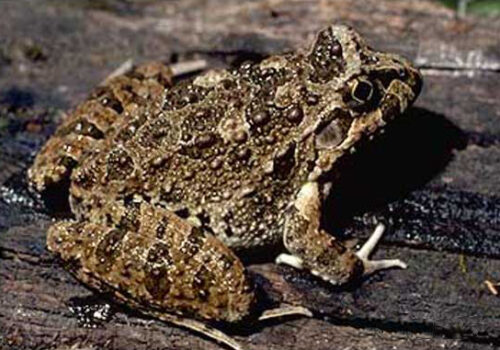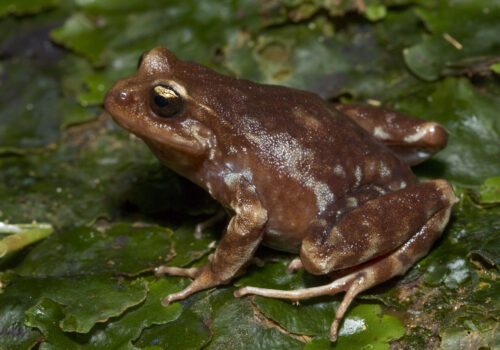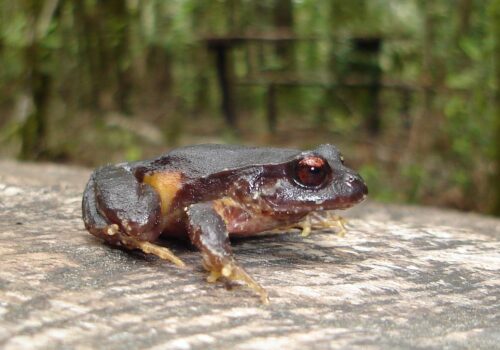- Alsodes Vittatus: Exploring the Secretive Life of Chile's Stripe-Thighed Frog
Alsodes Vittatus: Exploring the Secretive Life of Chile’s Stripe-Thighed Frog#
Beneath the canopy of Chile’s lush temperate forests, nestled among moss-laden rocks and burbling streams, quietly lives a remarkably little-known amphibian species. The Stripe-Thighed Frog, scientifically known as Alsodes vittatus, has long eluded attention, dwelling unobtrusively within its misty woodland habitat. Despite its quiet existence, this frog serves a critical role in its ecosystem, acting as both predator and prey and providing insight into environmental health. Perhaps most intriguingly, Alsodes vittatus harbors a unique set of adaptations perfectly suited to its temperate rainforest home—adaptations that few wildlife enthusiasts have had the pleasure of witnessing firsthand.
So what exactly makes the Stripe-Thighed Frog so fascinating, and why should we care deeply about its preservation? Let us embark on a journey deep into the forested landscapes of southern Chile, peeling back layers of moss and bark to unveil the hidden world of this distinctive amphibian.
Taxonomy and Classification#
The Stripe-Thighed Frog, Alsodes vittatus, belongs to the family Alsodidae, a family comprised of frogs primarily endemic to southern South America. Within this family, the genus Alsodes is notable for its adaptation to cool, moist habitats, many of which are highly specialized and limited in distribution.
First described scientifically by herpetologist René Philippi in 1902, Alsodes vittatus joined a genus revered for its resilience and ability to thrive amidst cold mountain streams and damp forest floors. Today, the genus Alsodes includes numerous sister species, each uniquely adapted to harsh climates and rugged terrains. Among its close relatives—Alsodes nodosus, Alsodes pehuenche, and others—the Stripe-Thighed Frog stands distinct due to subtle yet notable morphological and behavioral patterns uncovered by field biologists in recent decades.
Natural Habitat#
A Frog Amidst Chile’s Temperate Forests#
The natural distribution of Alsodes vittatus is remarkably restricted. Endemic to southern Chile, this species thrives primarily in the temperate rainforests and Andean foothill regions near lakes such as Lago Llanquihue and Lago Puyehue. Dense forests, sparkling streams, and moss-covered rocks form the idyllic stage upon which this secretive creature quietly orchestrates its life.
These temperate ecosystems, shaded by towering southern beeches—locally called “coigües” (Nothofagus dombeyi) and “ulmos” (Eucryphia cordifolia)—offer optimal conditions. Beneath their leafy cover, streams run cool and clear, carpeted by moss and lush understory plants. The humidity rarely dips, and the temperature remains refreshingly cool and consistent, conditions critical to the survival of amphibians like A. vittatus.
Specialized Habitat Preferences#
The Stripe-Thighed Frog inhabits forest clearings and stream banks, usually choosing locations where vegetation offers ample camouflage. Ideal habitats include shaded permanent streams, marshy areas, and waterlogged depressions dotted along forest floors. During the day, frogs tuck themselves under leaf litter, fallen logs, or beneath rocks, emerging at nightfall to feed, hydrate, and navigate their domain.
This selective preference for pristine water sources and minimal ecological disturbance positions Alsodes vittatus as a critical indicator species—signaling the health and stability of its habitat. Even subtle disturbances in the ecosystem can significantly impact their populations, underscoring the ecological dependency and vulnerability these frogs face.
Physical Characteristics#
The beauty and essence of Alsodes vittatus lie in its subtlety. With adult lengths ranging from merely 40-60 millimeters, this modest-sized amphibian displays quite an elusive charm. Their robust but compact bodies, powerful hind legs, and near-perfect camouflage enable them to seamlessly blend into their environmental canvas, escaping detection by even experienced naturalists.
Their skin coloration demonstrates varying shades of olive green, brown, and gray—a palette mirroring the earthy hues of their habitat’s forest floor. Their common name comes from distinctive darker markings running along the thighs, resembling delicate stripes. Furthermore, their dorsal surfaces are scattered sparsely with subtly-shaped warts and bumps, adding textures that effectively mimic leaf litter when motionless.
Large, observant eyes positioned slightly outward grant this frog astute peripheral vision, critical for spotting their insect prey and sensing predators around them. Webbed hind feet indicate partial aquatic adaptation, perfect for efficient movement in streams and standing water bodies.
Behavior and Life Cycle#
Nocturnal Hunters of the Southern Forests#
Under the dim glow of moonlight filtering through dense foliage, the Stripe-Thighed Frogs reveal their adept hunting strategies. Primarily insectivorous, they feast on various invertebrates—flies, moths, beetles, and other forest-floor crawlers. Their nocturnal lifestyle, combined with rapid lunges and tongue captures, ensures a steady and nutritious diet.
Unlike many tropical frogs famous for bold mating displays, the courtship behavior of Alsodes vittatus is a more subtle affair. Males make discreet vocalizations, usually soft and rhythmic croaking, designed to attract females and establish territorial limits. Their reproductive season coincides closely with regional rainfall patterns, typically during wet spring and summer months when streams swell, ensuring ample water for developing offspring.
Metamorphosis and Parental Efforts#
Reproduction for Stripe-Thighed Frogs involves laying gelatinous egg clusters firmly attached underwater rocks, logs, or submerged vegetation. These eggs hatch within a few weeks into delicately adapted tadpoles that remain hidden in aquatic refuges until they metamorphose into miniature adults. Interestingly, recent studies suggest instances of parental investment—adults frequently returning to egg-laying sites to indirectly guard offspring against potential threats, a fascinating behavioral trait warranting further scientific exploration.
Ecological Role#
Despite their inconspicuous demeanor, Alsodes vittatus frogs play crucial ecological roles within their intricate forest ecosystems. Primarily insectivorous, their predation significantly regulates insect populations—some of which are herbivores that could otherwise damage delicate vegetation.
Conversely, these frogs themselves become essential prey items for higher predators, including birds and small mammals, bridging crucial food-chains within their habitat. Their delicate health stands prominently as a canary in the coalmine—they serve as sensitive indicators of environmental stressors, including chemical contamination, climate change, and habitat alteration.
Threats and Conservation Status#
Regrettably, the pristine and specialized habitat requirements of Alsodes vittatus make them especially vulnerable to environmental shifts. Habitat fragmentation due to human encroachment, logging, and agriculture pose substantial threats. Climate threats, including altered rainfall patterns, directly threaten their reproduction and survival.
Currently listed as “Least Concern” by the IUCN Red List, conservationists caution that this apparent stability could swiftly decline if disturbances to habitats grow unchecked. Conservation efforts thus emphasize long-term habitat protection initiatives, engaging local communities and authorities in environmental stewardship and sustainable land-use practices.
Cultural and Scientific Significance#
In local Chilean folklore, amphibians often signify health, rain, fertility, and environmental balance. While cultural references specific to Alsodes vittatus are limited, it nevertheless shares the general symbolic respect amphibians receive across indigenous communities.
Scientifically, the species represents a compelling subject, particularly regarding ecological sensitivity and climate change study. Researchers studying species like Alsodes vittatus uncover critical data on ecosystem health, turning the humble amphibian into a powerful sentinel within our warming era.
Conclusion: Protecting a Hidden Treasure of Chile’s Forests#
The Stripe-Thighed Frog, despite living quietly hidden within the shadows and streams of Chile’s temperate forests, empowers us with powerful insights into conservation, ecology, and our environmental responsibilities. Understanding this species beyond its immediate allure grants us deeper appreciation and actionable knowledge. Let us advocate passionately for its wild habitat protection—it deserves no less than our vigilant care and stewardship.










